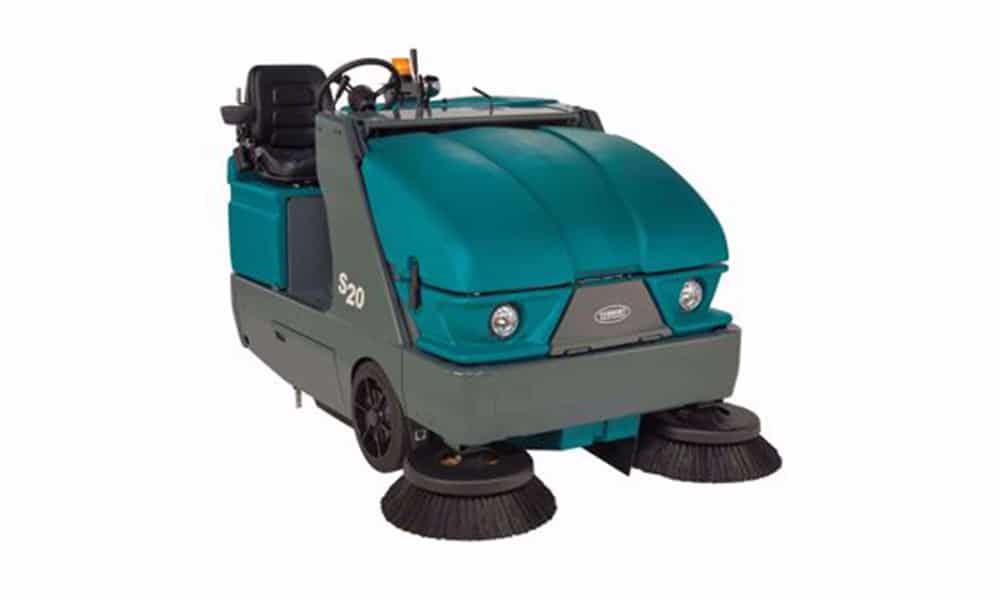Industrial warehouse sweepers are invaluable in maintaining cleanliness, efficiency, and safety in large warehouse environments. They offer a fast and effective solution to keep your industrial warehouse clean and dust-free, enhancing operational productivity.
Understanding Industrial Warehouse Sweepers:
Industrial sweepers are essential warehouse solutions. They utilize various technologies like brushes, vacuums, and dust control to collect dirt, debris, spills, and more from concrete, asphalt, epoxy, or other hard floor surfaces.
Defining Industrial Warehouse Sweepers
Industrial warehouse sweepers, sometimes called industrial floor sweepers, are heavy-duty cleaning machines explicitly designed for warehouses, distribution centers, manufacturing plants, and other commercial facilities with sizable hard surface floors.
They come in walk-behind manual models, ride-on battery-powered models, and tow-behind models for quick cleaning of aisles and open floor areas. They use rotating cylindrical main brushes, vacuum heads, dust control filters, and sweeping brooms to aggressively collect dry materials and loose debris across expansive hard floors.
These commercial-grade sweepers have numerous customizable features like hopper sizes, brush lengths, vacuum power, dust filtration, and sweeping path widths.
Different Types of Industrial Warehouse Sweepers
There are three main types of industrial floor sweepers used in modern warehouses and distribution centers:
- Manual push sweepers: These primary manual sweepers use a push broom style brush design powered via the operator’s movement to collect light debris across concrete floors.
- Walk-behind sweepers: These electric and battery-powered models use main cylindrical brushes and vacuums to sweep and collect debris efficiently across warehouse aisles and tight spaces.
- Ride-on sweepers: These heavy-duty battery-powered sweepers have sweeping paths typically over 60″ wide and feature an operator compartment with controls to drive the unit across large warehouse floors for faster, expansive area cleaning.
Tow-behind models connected to tuggers, forklifts, and other vehicles are standard options. Choosing the right sweeper type depends on the warehouse size, floors, debris, sweep frequency, operator skill, and other factors.
How Industrial Warehouse Sweepers Work
While features vary across models, industrial warehouse sweepers commonly utilize a cylindrical main sweeper roller brush powered by electric motors to aggressively sweep and flick debris into the unit’s hopper bin. This rotating brush contacts the floor at an angle, using synthetic bristles to displace and collect dirt, small rocks, metal scraps, powder, wood pieces, glass fragments, spills, and other hazardous or loose materials across the warehouse floor’s surface.
Rotational speeds often reach over 1000 RPM to sweep aggressively. Behind the main brush, a dual chamber hopper bin uses vacuum suction, vibration, and directional vanes to transfer the swept debris from the floor into the interior collection tank or bags. Filters prevent fine dust from re-entering the environment.
Operator controls allow adjusting brush pressure against the concrete flooring based on debris volumes. Durable steel frame constructions withstand harsh warehouse environments. Rechargeable batteries provide runtimes over 4+ hours per charge. Additional features like side brushes, dust control, and autonomous technologies on some riders enhance cleaning path widths and effectiveness.
Significant Advantages of Industrial Floor Sweepers:
From improving warehouse storage conditions to improving building automation and productivity, warehouse sweepers offer many advantages, including:
Improved Productivity
Industrial warehouse sweeper models like ride-on battery sweepers can clean sealed concrete floors across 20,000+ square foot warehouses significantly faster than walk-behind sweepers and manual brooms.
Their expanded cleaning path widths over 60″ minimize the number of passes needed to cover large areas. Autonomous rider models also allow sweeping floors without an operator continuously driving the unit. This improved floor cleaning productivity keeps warehouse operations flowing optimally by reducing downtimes.
Cost-Effective Cleaning Solution
Though industrial riders and large walk-behinds represent significant upfront investments over push brooms, their automated cleaning capabilities prove more economical in daily operations across commercial facilities.
Rapidly sweeping debris that could otherwise damage material handling vehicles, clog narrow spaces, or create slip/fall hazards minimizes costly unintended shutdowns and maintenance repairs.
Their rechargeable battery configurations also eliminate recurring fuel costs associated with fossil fuel-powered floor scrubbers and sweepers.
Ensures Health and Safety
Industrial sweepers support warehouse employee health and safety by resolving dangerous slip, trip, and fall hazards created by loose debris accumulations across distribution center floors before they escalate into recorded incidents.
They contain messy debris by transferring it directly into enclosed hoppers instead of moving materials across operational areas. Integrated dust filtration also manages fine particulates during sweeping to support better air quality.
Environmental Friendliness and Energy Efficiency
Eco-friendly rechargeable battery power sources allow industrial warehouse sweepers to operate free of emissions and engine noise, supporting green warehouse initiatives.
Variable operating speeds and brush pressure settings also allow customizing runtimes to support energy conservation based on actual floor debris levels, minimizing unnecessary energy waste that occurs with constant fossil fuel-based operation.
Extends Lifespan of the Warehouse Floors
Industrial sweepers protect concrete, sealed concrete, epoxy, and other floor coatings from unnecessary damage associated with accumulated debris. Collection systems minimize surface scratching vs push brooms.
This maintains the floor’s durability through expected wear without requiring extensive joint repairs, new overlay applications, and other fixes, saving thousands in potential floor renovation costs.
Financing equipment like warehouse sweepers can be difficult for budding companies. Check out this article for tips and tricks for financing your warehouse equipment.
Key Factors to Consider When Choosing Industrial Warehouse Sweepers:
There are several things that can factor into a good warehouse-sweeping solution, such as:
Size and Design of the Warehouse
Available space across warehouse aisles and main floors, along with overall square footage, should dictate selecting compact 32″ walk-behinds vs large rider sweepers over 60″ wide. Consider obstructions like support columns or inventory racks that limit turning radii.
Functional Requirements
Needed cleaning path width, runtime duration, hopper capacity, filtration needs, battery vs manual power, and debris volumes expected based on activities like shipping/receiving, manufacturing, or product storage should drive precise sweeper selection.
Warehousing Operation Type
High-traffic warehouses with continual debris volumes from vehicle movements may benefit from larger rider sweepers for daily cleaning. In contrast, more static storage facilities can rely on smaller walk-behinds for weekly/monthly maintenance.
Warehouse Sweepers From HTX Material Handling Can Transform Your Space
Don’t let your warehouse fall behind on cleanliness. It can be easy to overlook sweeping regularly in your material handling spaces, but that’s where HTX comes in. Our warehouse sweepers can keep your business at peak performance. Contact HTX today for a free consultation.

